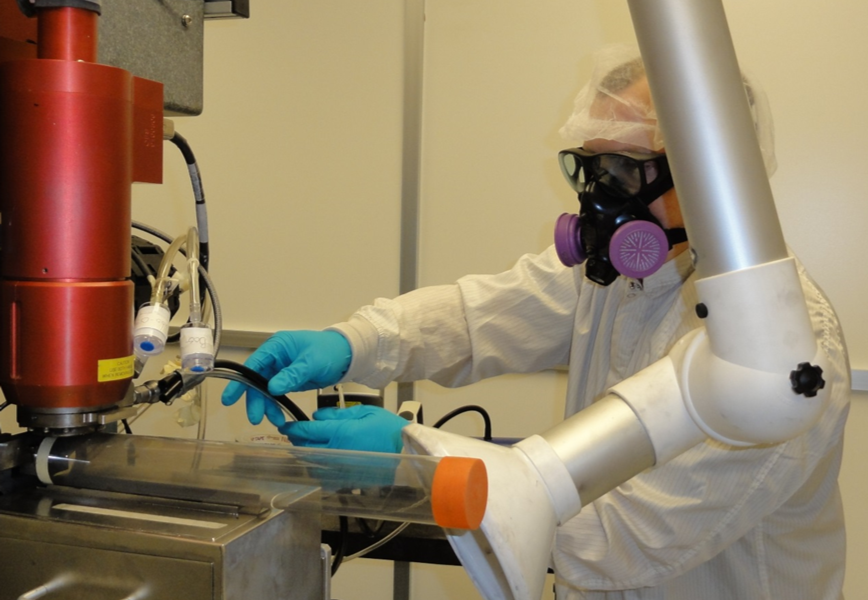Never fear! NEAT 2.0 is here! – How to perform nanomaterial exposure assessment in the workplace
Posted on by
Do you think you might have exposure to nanomaterials in your workplace? Never fear! NEAT 2.0 is here!
Engineered nanoparticles are unique. They are generally smaller than both red blood cells and viruses, don’t weigh much, and have a great amount of surface area proportionate to their size. These particles are increasingly used in a wide variety of products, ranging from cosmetics to concrete. Workers who make and use engineered nanoparticles would be the first potentially exposed to any new material. So, it seems important to be able to determine whether workers are exposed to these materials in an occupational setting, right?
Because of the unique properties of these materials, it can be a challenge to identify whether there is a potential for worker inhalation exposure. Why? Well, first because they are so small it is difficult to see nanoparticles unless we use electron microscopy, which is time consuming and expensive. Second, even if we collect a sample and weigh it, there may not be enough mass to be detected. Traditional industrial materials, composed of particles that are larger in size, do not pose such hurdles for sampling and analyzing. So with these challenges, how do we identify if nanomaterials present the potential for occupational inhalation exposure in a workplace?
NIOSH has been researching this very question for over a decade. In 2009, based on both laboratory research and field investigations, NIOSH developed and was the first to recommend using the nanoparticle emission assessment technique (NEAT).[1],[2],[3] This technique made use of a condensation particle counter that could be used to identify tasks that result or can result in the emission of nanoparticles into the surrounding air. Then, task-based filter samples were used to confirm the presence of these materials, using both laboratory elemental analysis and electron microscopy. This initial approach didn’t effectively address the potential for background contamination from incidental nano-sized particles (unrelated to emissions from the work process being studied) or exposure over a full workday. In addition, it was heavily dependent on the use of direct reading instruments (DRIs), which are nonspecific aerosol monitors and subject to interferences such as background incidental particles. So, based on the need to surmount these limitations, and a desire to learn more about potential occupational exposures, NEAT was updated.
Refinement of the Nanoparticle Emission Assessment Technique into the Nanomaterial Exposure Assessment Technique (NEAT 2.0) was recently published in the Journal of Occupational and Environmental Hygiene.[4] This is a more robust sampling strategy that places a stronger emphasis on full workday exposures, incorporates background monitoring, and emphasizes the importance of integrated filter sampling in the worker’s breathing zone over the use of DRIs. This refined sampling strategy consists of the following important steps:4
- Collect Basic Workplace Information
- Work flow, number of workers, tasks performed, materials used, other indicators of potential exposure
- Design and Implement the Sampling Plan
- Full-shift and task-based integrated filter sampling, DRIs, evaluate engineering controls
- Risk Assessment
- Evaluate data: Background, engineering controls
- Use hierarchy of controls to develop mitigation strategies for exposure potential
- Communicate potential risks
- Risk Management
- Confirm ongoing control of risk by performing additional measurements, if necessary
In performing the steps above, a comprehensive exposure assessment can be performed and assist with the identification of potential nanomaterial exposure in an occupational setting. Additional guidance regarding the NEAT 2.0 refined sampling strategy can be found here.
This updated technique will guide facilities in determining exposure potential for workers who are handling or using engineered nanomaterials. By determining exposure potential, the facility can then work to control exposure making use of mitigation strategies and the hierarchy of controls.
Lt. Adrienne Eastlake, MS, RS/REHS, is an Industrial Hygienist in the NIOSH Nanotechnology Research Center.
References
[1] Methner M, Beaucham C, Crawford C, Hodson L, & Geraci C. (2012). Field Application of the Nanoparticle Emission Assessment Technique (NEAT): Task-Based Air Monitoring During the Processing of Engineered Nanomaterials (ENM) at Four Facilities. JOEH. 9(9):543-555. doi:10.1080/15459624.2012.699388.
[2] Methner M, Hodson L, Dames A, & Geraci C. (2010). Nanoparticle emission assessment technique (NEAT) for the identification and measurement of potential inhalation exposure to engineered nanomaterials—Part B: Results from 12 field studies. JOEH, 7(3), 163-176. doi:10.1080/15459620903508066.
[3] Methner M, Hodson L, & Geraci C. (2010). Nanoparticle emission assessment technique (NEAT) for the identification and measurement of potential inhalation exposure to engineered nanomaterials—Part A. JOEH, 7(3), pp.127-132. doi:10.1080/15459620903476355.
[4] Eastlake A, Beaucham C, Martinez K, Dahm M, Sparks C, Hodson L, & Geraci C. (2016). Refinement of the Nanoparticle Emission Assessment Technique into the Nanomaterial Exposure Assessment Technique (NEAT 2.0). JOEH, 13(9). doi:10.1080/15459624.2016.1167278.
Post a Comment